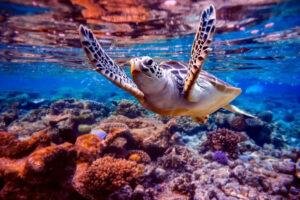
Why in news?
The Hawksbill Turtle Single Species Action Plan was recently approved by the 14th Conference of the Parties to the Convention on the Conservation of Migratory Species of Wild Animals (CMS COP14).
Concerning the Global Single Species Action Plan:
- It is the principal tool created in accordance with the African-Eurasian Migratory Waterbird Agreement (AEWA).
- The aim of these action plans is to restore migratory waterbird species to a favorable conservation status by the adoption of coordinated measures.
- The execution of these plans requires international cooperation among the range states of the species.
Agreement on the Conservation of African- Eurasian Migratory Waterbirds (AEWA)
- An intergovernmental agreement known as the Agreement on the Conservation of African-Eurasian Migratory Waterbirds (AEWA) was created to protect migratory waterbirds and their habitats throughout Africa, Europe, the Middle East, Central Asia, Greenland, and the Canadian Archipelago.
- It is managed by the United Nations Environment Programme (UNEP) and created in accordance with the Convention on Migratory Species (CMS).
- In an attempt to promote coordinated conservation and management of migratory waterbirds throughout their full migratory range, it brings together nations and the larger international conservation community.
- It includes 255 species of migratory waterbirds whose annual cycle depends at least partially on wetlands.
- The Agreement region encompasses 119 Range States from Africa, Europe, the Middle East, and portions of Asia and Canada, and it extends from the northernmost tip of Africa to the southernmost tip of the Russian Federation.
- Three primary bodies comprise the Agreement:
- The Meeting of the Parties (MOP), which is in charge of overseeing AEWA’s operations in between MOP meetings, the Standing Committee (StC), which directs MOP operations, and the Technical Committee (TC), which offers scientific and technical guidance.
- The Parties and the Agreement’s bodies are supported by the UNEP/AEWA Secretariat, which is headquartered in Bonn, Germany.
About the Convention on the Conservation of Migratory Species of Wild Animals (CMS)
- Name and Purpose: The Convention on the Conservation of Migratory Species of Wild Animals (CMS), an environmental treaty under the United Nations, aims to provide a global platform for the conservation and sustainable use of migratory animals and their habitats.
- Collaborative Effort: CMS brings together governments and wildlife experts worldwide to address the conservation needs of terrestrial, aquatic, and avian migratory species and their habitats.
- Establishment: The Convention entered into force in 1979, marking the beginning of concerted international efforts for migratory species conservation.
- Membership: Since its inception, the CMS has seen significant growth in membership, with 133 Parties from Africa, Central and South America, Asia, Europe, and Oceania currently participating in the treaty.
About the Conference of the Parties (COP)
- Principal Decision-Making Body:The Conference of the Parties (COP) serves as the primary decision-making body of the Convention on the Conservation of Migratory Species of Wild Animals (CMS), as outlined in Article VII of the CMS text.
- Frequency of Meetings: COP convenes once every three years to address various aspects of the Convention’s implementation and operation.
- Setting Budget and Priorities: During each meeting, COP determines the budget and establishes priorities for the following three years, known as the triennium.
- Amendment of Appendices: COP has the authority to decide on the amendment of the Appendices of the Convention, which list migratory species requiring international cooperation for conservation.
- Consideration of Reports: COP considers reports submitted by the Parties to the Convention, as well as reports from the Scientific Council and any Agreements established under the CMS framework. These reports provide updates on the status of migratory species and conservation efforts.
People also ask
Q1: What is a species action plan?
Ans : Species Action Plans outline the steps that must be taken to conserve a species in order to reduce the effects of identified threats, enhance habitat, and organize conservation activities.